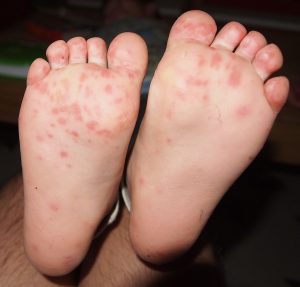
Hand, foot, and mouth disease is a common childhood illness characterized by a blistering rash. It is caused by the Coxsackie virus, and because it is a viral illness, it does not require antibiotics for treatment. While it is most common in younger children from about 6 months of age until 4 years of age, children of any age can be affected. It is most prevalent during the summer and fall and is often spread through daycares.
Symptoms
- Fever (temperature above 100.4)
- Painful sores in the mouth (sometimes difficult to see, but manifest as feeding refusal in infants and complaints of mouth pain in older children)
- Blisters/rash on the palms of the hands and the soles of the feet
- Blistering rash is often also present on lower legs, forearms, and buttocks

How long does it typically last?
- Fever lasts for approximately 3 days
- Mouth sores last for approximately 7 days
- Rash can be present for up to 10 days
What is the treatment for this illness?
The treatment for hand, foot, and mouth disease is all supportive care. For fever, you may give appropriate doses of Tylenol or ibuprofen (note – never give ibuprofen to infants younger than 6 months of age). The rash is typically not painful, but the mouth sores can be very uncomfortable. It is important to keep kids hydrated, which is sometimes difficult to do when their mouth hurts. For mouth sores, the following suggestions may be helpful:
- Feed soft foods, such as yogurt or Jell-O
- Try cold foods, such as ice cream, milkshakes, or popsicles
- Avoid salty, spicy, acidic, and citrus foods
- Take Tylenol or ibuprofen 30 minutes before a meal
Create your own “Magic Mouthwash”
- Mix equal parts Children’s Liquid Benadryl and Maalox
For infants and young children, dab the mixture on visible sores every 6 hours as needed. Another option for infants and young children is placing ½ teaspoon of Maalox in the front of their mouth every 6 hours as needed. Older children may swish and spit 1-2 teaspoons of the above mixture every 6 hours.
How long is my child contagious?
Your child will likely get sick 3-6 days after exposure. Typically, children are no longer contagious when the fever is gone; however, if your child has many blisters or a significant rash, they should remain home until all the blisters have crusted over.
When should I contact the clinic?
Hand, foot, and mouth can typically be managed at home. Please call our office or seek care if your child has not urinated in 8 hours, the fever lasts longer than 5 days, or for any other concerns.
Related Stories



